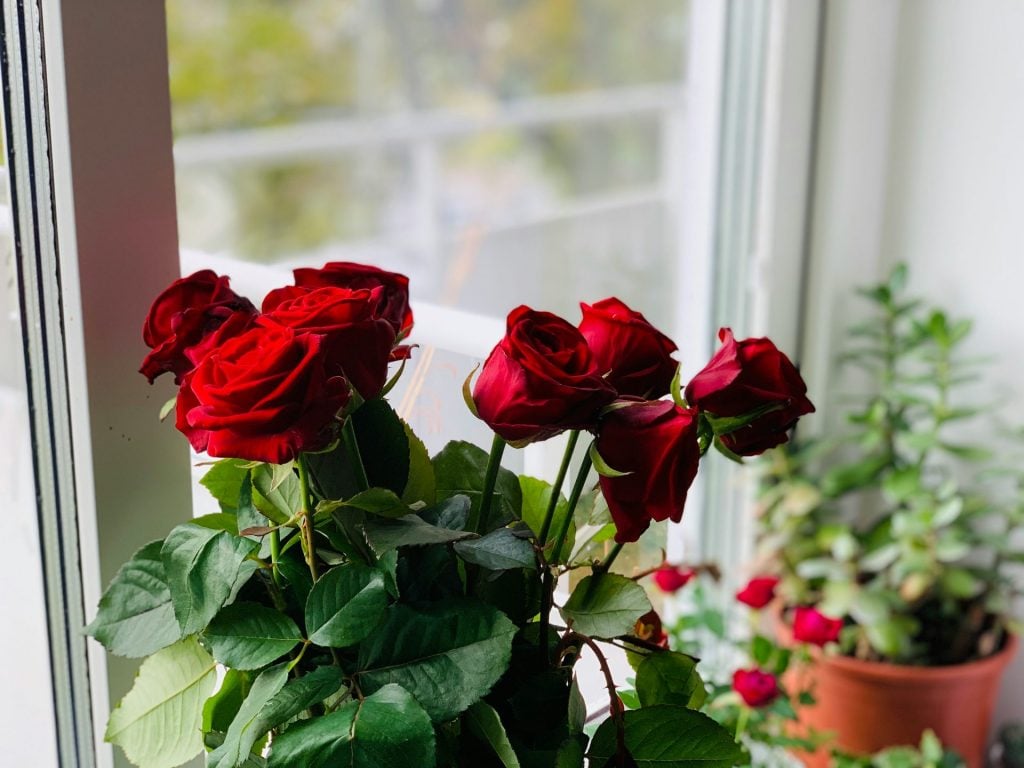Helping Roses Open After They Are Cut
We often hear that we should cut roses while they are still in bud form. This is true to a certain extent and you may have noticed that florists usually deliver roses that are not fully opened. This is because it means that they will last as long as possible. That said, if you have a bunch of roses that are still in bud form, they might not open if you don’t help them along a little. Fortunately, if you follow these steps, you will know how to get roses to open in a vase.

Step 1:
Fill a large bucket with some lukewarm water, I usually do this in my sink. This temperature water is easier for the stems to absorb water and nutrients quickly and effectively. The water should not be too hot or cold or it will do more harm than good.
Step 2:
Submerge the flowers until just below the buds. Don’t submerge the buds as this can actually hurt the flowers instead of helping them.
Step 3:
Trim each stem under water and do so at a 45 degree angle. This will ensure that the stems does not rest flat on the bottom of the vase. It’s also important to trim the stems under water so that air bubbles don’t get into the stem and impede absorption. Proper absorption will encourage the roses to open up completely and without too much delay. I like to make sure I have a nice pair of sharp scissors or flower snips for this part.
Step 4:
Remove extra leaves from the stems. You don’t want the nutrients to go to the leaves when they can go to the flower instead. This means that all the water and food absorbed by the stem will help the rose stay fresh and last longer. However if you are like me and like the stems with a few leaves on them, then that alright too.
Step 5:
Fill your clean vase with some room temperature water and add floral preserve. Let the preserve dissolve completely before adding your flower to the vase and keep your bouquet away from heat, air conditioners, direct sunlight, and wind. Roses can brighten up a room, so I like to put them where they stand out like a dinner or side table.
Step 6:
Once your roses are in the vase, you can take a few minutes to lightly pull the petals at the tops of the buds. This will encourage them to open up. Don’t be too rough or you could cause damage. You should only pry the petals open a few millimetres each time. Check for guard petals and remove the guard petals since they can hold the bud shut, these are the outer layer of petals on the buds.
It is important to remember that these guard petals are NOT a reflection of the health or quality of the roses,” according to rose grower Vivaroses.
https://www.southernliving.com/garden/flowers/how-to-keep-cut-roses-alive
Make sure that you change the vase water regularly and trim the stems every few days to make it easier for them to absorb water and nutrients. Every time you change the water, you should add more flower preserves to make sure that they are provided with everything they need.
Reasons Roses Wilt
It’s important to know if your roses are wilting too quickly and when you can help slow the process. Understanding why roses wilt can help you take better care of them. Here are some common reasons:
- Water Loss: The most common cause is simple dehydration. Roses lose water faster than they can absorb it, especially in warm conditions or when left out of water too long.
- Stem Blockage: Air bubbles or bacteria in the stem can impede water uptake, even when the roses are in water.
- Poor Quality: Roses cut too early or kept in cold storage for extended periods may be beyond revival.
- Ethylene Exposure: Proximity to ripening fruits and vegetables can accelerate aging in roses.
What To Do When Your Roses Wilt
Throughout the years, I have tested numerous techniques to revive drooping roses but the most effective one I always come back too is the following:
- Take the roses out of the vase.
- Trim the stems at a 45-degree angle, about an inch from the end.
- Immerse the entire rose in a sink filled with water.
- Keep them submerged for at least 30 minutes.
- In the meantime, clean the vase thoroughly and fill it with fresh, cold water and a bit of flower preserve.
- After soaking, trim the stems underwater again and place them back in the cleaned vase.
This straightforward process usually revives the roses within hours, bringing them back to their prime.
Garden Rose Care
Roses have strong roots, which helps them take moisture from the soil. Once they are established, they usually do well by themselves. However, during hot and dry times or in sandy soil, I like to give them extra water to ensure they are getting all the nutrients they need. In their first few years after planting, new roses should be watered regularly, especially in summer, until their roots are well established.
If the blooms or leaves start to wilt, then water immediately. I usually use a large watering can full of water to ensure the rose bush is getting enough water. A tip I follow is to give plants a good soak once a week. Instead of watering them lightly more often, this helps the roots grow deeper. Deeper roots allow the plants to find moisture in the soil more easily and live longer.

Feeding
I like to add rose fertilizer to the soil around my plants two times a year. This helps them grow better. Roses need a lot of nutrients, so giving them extra helps them thrive.
When to feed:
- in March/April before bloom
- In mid-summer, after the first bloom of flowers, especially for types that flower again.
Weeding
It’s important to keep the area around your rose plant clear of weeds. Roses have roots that grow close to the soil surface. To avoid hurting these roots, it’s best to remove weeds by hand instead of using a hoe.
Deadheading
Deadheading roses means taking off the old flowers. This helps the plant grow more flowers and look better.
To deadhead, cut the faded flower just below the first set of five leaves. For hybrid tea roses, you can also snap off the stem. This way, the plant focuses its energy on making new blooms instead of seed pods.
I do find deadheading is best done as soon as flowers fade, but I like to space them out every few days or once a week to make it more manageable.





